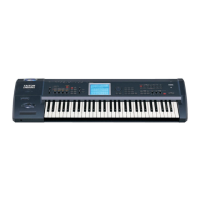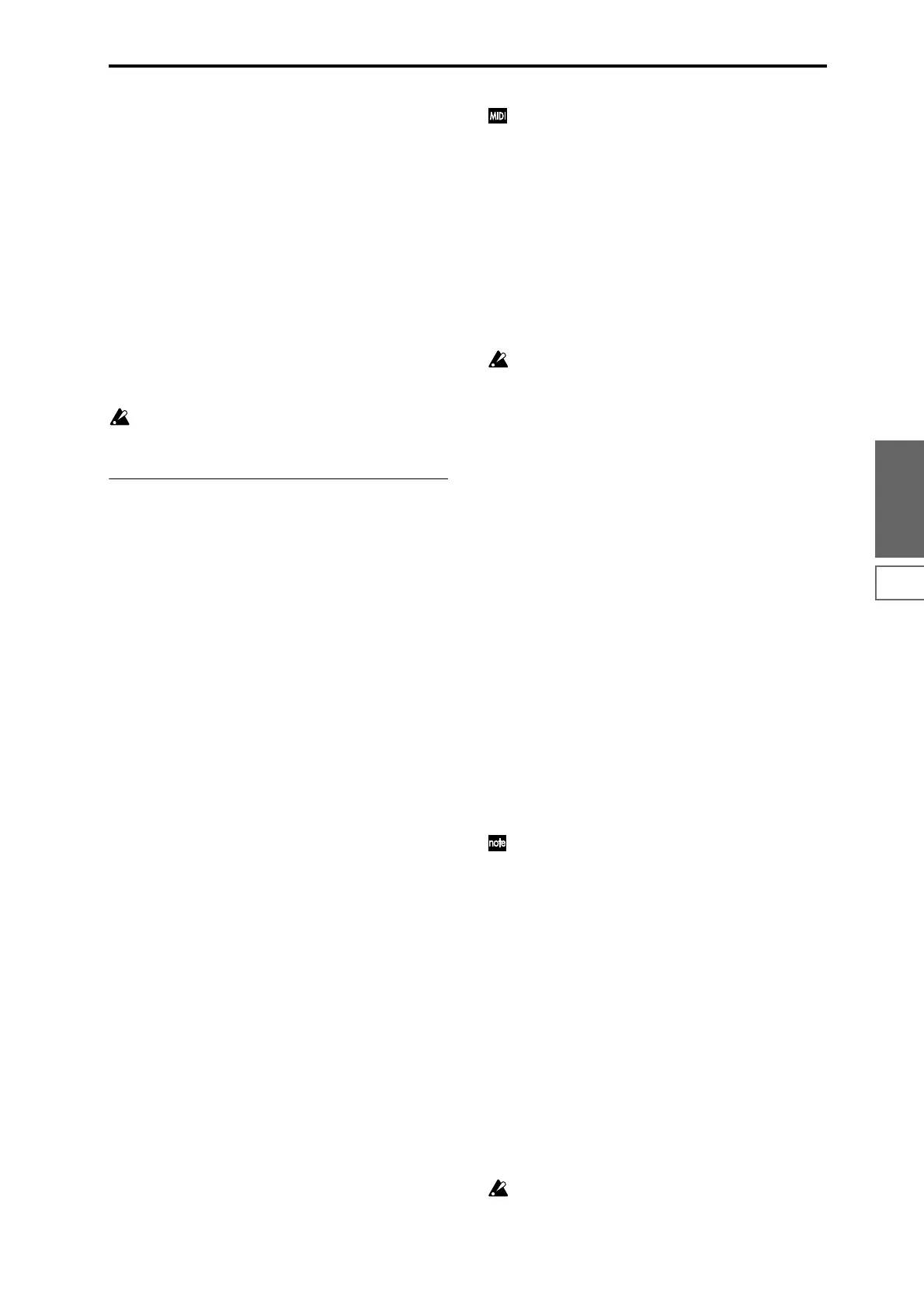115
Sampling
P0
P1 P2 P3 P4 P5 P8 P9
Pan [L000...C064...R127]
Specifies the panning of the external audio signal being
input (specified by “Input”). When inputting a stereo audio
source, you will normally set Input1 to L000 and Input2 to
R127. (For example settings, ☞p.107, QS p.24, OG p.67)
BUS (IFX/Indiv.) Select
[L/R, IFX1...5, 1, 2, 3(Tube), 4(Tube), 1/2, 3/4(Tube), Off]
Specifies the bus to which the external audio signal will be
sent.
L/R: The external audio signal will be sent to the L/R bus.
Normally you will select L/R.
IFX1...5: The external audio signal will be sent to the corre-
sponding IFX1–5 bus. Select this when you want to apply an
insert effect while sampling.
1, 2, 3(Tube), 4(Tube): The external audio signal will be sent
to the corresponding bus(s) 1–4.
Off: The external audio signal will not be input.
If you want insert Valve Force into an external audio
signal and sample it, select 3/4(Tube), 3(Tube), or
4(Tube). Set the Valve Force “Placement” to Insert.
0–2b: Recording Setup
Source BUS [L/R, Indiv.1/2]
Selects the source that you want to sample. The sound being
sent to this bus will be sampled.
L/R: The sound being sent to the L/R bus will be sampled.
The external audio signal(s) (specified by “Input” 0–2a) sent
to the L/R bus, and the sound played by the TRITON
Extreme from its keyboard or from MIDI input etc. and sent
to the L/R bus, will be sampled. You will also use the L/R
setting when sampling a sound processed by an insert effect.
Indiv.1/2: The sound being sent to the INDIVIDUAL 1, 2, or
1/2 buses will be sampled.
The external audio signal(s) (specified by “Input” 0–2a) sent
to the 1, 2, or 1/2 buses, and the sound played by the TRI-
TON Extreme from its keyboard or from MIDI input etc. and
sent to the INDIVIDUAL 1, 2, or 1/2 buses, will be sampled.
Trigger [Sampling START SW, Note On, Threshold]
Specifies how sampling will be initiated.
Sampling START SW: Pressing the SAMPLING [REC] key
will cause the TRITON Extreme to enter sampling-standby
mode, and sampling will begin when you press the SAM-
PLING [START/STOP] key.
1 Press the SAMPLING [REC] key to enter sampling-
standby mode.
2 Use the “Recording Level [dB]” slider to adjust the sam-
pling level.
3 Sampling will begin when you press the SAMPLING
[START/STOP] key. (If you are using the “Metronome
Precount” function, pressing the SAMPLING [START/
STOP] key will cause sampling to begin after the metro-
nome sounds a count-down. If Metronome Setup “BUS
(Output) Select” (0–3c) is set to L/R, the metronome will
stop sounding at the moment that sampling begins.
4 To stop sampling, press the [START/STOP] key once
again. Sampling will also stop automatically if it contin-
ues to the specified “Sample Time” (0–1c).
If you want to apply an effect etc. to an existing sample and
automatically create a new sample (Resampling), set “Trig-
ger” to Sampling START SW, and set “Resample” (0–2b) to
Auto. (☞“Resample” Auto)
Note On: Sampling will begin when you play the keyboard
after having pressing the SAMPLING [REC] key and then
the SAMPLING [START/STOP] key.
Sampling will also begin if a MIDI note-on is received
(instead of playing the keyboard).
1 Perform steps 1 and 2, above.
2 Press the SAMPLING [START/STOP] key.
3 When you play the keyboard or when a MIDI note-on is
received, sampling will start automatically.
4 To stop sampling, perform step 4, above.
Threshold: Sampling will begin automatically when the
input level exceeds the specified “Level.”
1 Press the SAMPLING [REC] key to enter sampling-
standby mode.
2 Use the “Recording Level [dB]” slider to adjust the sam-
pling level.
Be careful of the change in the monitoring volume.
(“Recording Level [dB]” 0–1d)
3 Adjust the “Level” setting. The black triangles at both
sides of the “Recording Level [dB]” level bar display will
indicate the “Level” value. Normally you will set this to a
low a level as possible without allowing sampling to be
triggered by noise.
4 Press the SAMPLING [START/STOP] key. When the
input level exceeds the “Level” you specified, sampling
will begin automatically.
5 To stop sampling, press the [START/STOP] key once
again. Alternatively, sampling will end automatically if it
continues to the time specified for “Sample Time” (0–1c).
Metronome Precount [Off, 4, 8, 3, 6]
Specifies whether the metronome will sound a countdown
when you use “Trigger” Sampling START SW to begin
sampling.
This can be set only if “Trigger” is set to Sampling START
SW.
Off: Sampling will begin immediately when you press the
SAMPLING [START/STOP] key from recording-standby
mode.
4, 8, 3, 6: When you press the SAMPLING [START/STOP]
key from recording-standby mode, the metronome will
count the specified number of beats at the “ (Tempo)”
tempo, and then sampling will begin. If you set this to 4,
sampling will begin on the count of 0 after a pre-count of 4–
3–2–1–0.
The output destination and level of the metronome
sound are specified by Metronome Setup (0–3c).
Resample [Manual, Auto]
Specifies how resampling will occur.
This can be set only if “Trigger” is set to Sampling START
SW.
The process of sampling a sample (or samples) is called “res-
ampling.”
You can apply effects to a sample and then resample it, or
resample a performance of samples that you play.
Manual: This is the normal method. Use this when you want
to sample an external input sound. If a sample is already
assigned, the sample assigned for playing from the keyboard
will be resampled together with the external input sound.
Auto: The sample assigned to the index will be resampled
automatically. Use this when you want to apply an effect or
Valve Force to a sample and resample it.
1 Set “Key” to the keyboard location where the sample you
that you want to resample is assigned.
Sampling will not be possible if you specify a key to
which a sample has not been assigned.

